- Home
- Concerts & Events
- Plan Your Experience
- About
- Initiatives & Community
- Get Involved
- Support
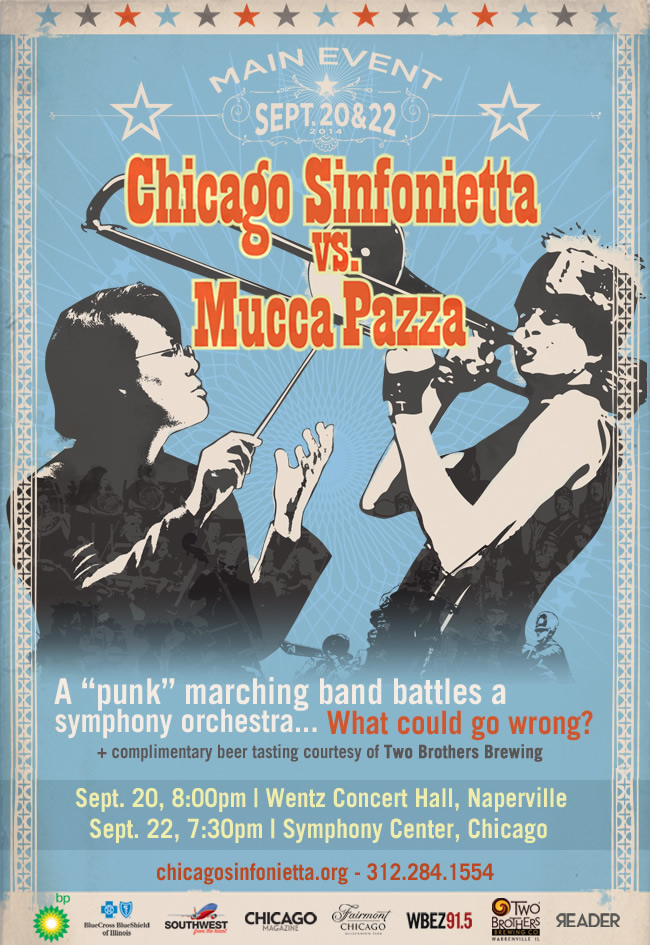
Rethink. Redefine. Reimagine. Throughout its history, the Chicago Sinfonietta has upended notions of what a symphonic concert should be, opting instead to consider what it could be. Nowhere, perhaps, is this more evident than in our season opening concert, featuring the engagement of Chicago’s notorious “punk marching band” Mucca Pazza. Rally up for what will surely be a vigorous musical exchange and prepare for the Sinfonietta to once again raise possibilities that only come through imagining “What if…”
THE
ARTISTS
Mei-Ann Chen, Music Director and Conductor
 Mei-Ann Chen begins her fourth season as Chicago Sinfonietta's Music Director. In her short time with the orchestra, she has brought the orchestra to new artistic heights, developing an aggressively adventurous approach to repertoire and collaboration while firmly anchoring her ambitious plans in the Sinfonietta’s quarter-century heritage of diversity, inclusion and service to the community. In the process, she has earned two awards from the League of American Orchestra: The Helen M. Thompson Award, given to a music director every two years to recognize their impact and potential for a significant national career, and one for the orchestra, a First Place Award for Adventurous Programming.
Mei-Ann Chen begins her fourth season as Chicago Sinfonietta's Music Director. In her short time with the orchestra, she has brought the orchestra to new artistic heights, developing an aggressively adventurous approach to repertoire and collaboration while firmly anchoring her ambitious plans in the Sinfonietta’s quarter-century heritage of diversity, inclusion and service to the community. In the process, she has earned two awards from the League of American Orchestra: The Helen M. Thompson Award, given to a music director every two years to recognize their impact and potential for a significant national career, and one for the orchestra, a First Place Award for Adventurous Programming.
As the Chicago Tribune’s John von Rhein has remarked, “Mei-Ann Chen…was born to lead this group. She plays and speaks from the heart, the body and the head, and the audience and players have embraced her.” There’s also this from the Chicagoist blog: “We love Chicago Sinfonietta’s approach to classical music: it really opens it up to a new audience and makes it approachable and interesting.”
Born in Taiwan, Ms. Chen has lived in the United States since 1989. She holds a Doctor of Musical Arts degree in conducting from the University of Michigan, where she was a student of Kenneth Kiesler. Prior to that, she was the first student in New England Conservatory’s history to receive master’s degrees, simultaneously, in both violin and conducting. She is also the Music Director of the Memphis Symphony Orchestra and is in high demand around the globe as a guest conductor.
Mei-Ann Chen’s complete biography can be found here.
Mei-Ann recently spoke at the Aspen Ideas Festival, and while there, she sat down with HuffPost Live for a wide ranging conversation about creativity, gender roles and giving back to the community. To view the interview, click here.
In this video, Maestro Chen previews our season opening concert.
Mucca Pazza, Punk Marching Band
 It’s probably helpful to clear something up right off the bat. Mucca Pazza doesn’t exactly march. But they don’t really sit still either, even when they are sitting. There is, thankfully, nothing even vaguely militaristic about them. Yes, there’s a lot of brass and drums (not to be confused with drum ‘n bass), and there are cheerleaders and (mismatched) uniforms. As their publicity cheekily puts it, “Mucca Pazza was born in a steel mill parking lot along the Chicago River. Combining marching band traditions and street theater experiences with rock band sensibilities, Mucca Pazza quickly found a home for its 30-odd members in the thriving Chicago underground music scene.”
It’s probably helpful to clear something up right off the bat. Mucca Pazza doesn’t exactly march. But they don’t really sit still either, even when they are sitting. There is, thankfully, nothing even vaguely militaristic about them. Yes, there’s a lot of brass and drums (not to be confused with drum ‘n bass), and there are cheerleaders and (mismatched) uniforms. As their publicity cheekily puts it, “Mucca Pazza was born in a steel mill parking lot along the Chicago River. Combining marching band traditions and street theater experiences with rock band sensibilities, Mucca Pazza quickly found a home for its 30-odd members in the thriving Chicago underground music scene.”
Confused yet? OK, think of a college half-time show between two historically black universities, but played in the Balkans. Throw in a New Orleans second line groove, then season generously with electric guitars and serve with a side of Raymond Scott’s Bugs Bunny cartoon music. Now you’re getting close, but that doesn’t begin to describe their visual flair, touch of slapstick comedy, and those loudspeakers they attach to their heads.
Mucca Pazza has a lively website where you can dig a little deeper. To check it out, click here.
The video here is from the Montreal International Jazz Festival, and it kind of reminds me of Shostakovich, if Shostakovich were a surrealist instead of a dour Soviet.
THE
COMPOSERS
- Ralph Vaughan Williams
- Florence Price
- Benjamin Britten
- Mark Messing
- Gustav Mahler
- Dave Smith
- Pyotr Ilyich Tchaikovsky
Ralph Vaughan Williams
English Folk Song Suite
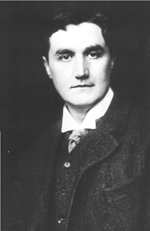 The concert will ease into the marching mood with something a bit more militaristic. Ralph Vaughan Williams wrote this three-part suite in 1923, when England’s empire had not yet begun to shrink. Its jaunty mood is consistent with that of a nation that emerged victorious from World War I, the rumblings of Indian independence still two decades in the future. Vaughan Williams was a collector and preserver as well as a composer, working to save traditional folk songs and carols from extinction.
The concert will ease into the marching mood with something a bit more militaristic. Ralph Vaughan Williams wrote this three-part suite in 1923, when England’s empire had not yet begun to shrink. Its jaunty mood is consistent with that of a nation that emerged victorious from World War I, the rumblings of Indian independence still two decades in the future. Vaughan Williams was a collector and preserver as well as a composer, working to save traditional folk songs and carols from extinction.
The work is one his most well-known works for military band, but other than this, Vaughn Williams was mostly known for more pastoral works and hymns that celebrate the English countryside and spirituality. Vaughan Williams served in WWI even though he was already 41 years old, but his works immediately following this service generally are still pastoral and almost mystical in nature. And, indeed, the two more march-like movements of this suite are separated by a lengthy pastoral interlude. There is more dissonance in the composer’s later works, perhaps coinciding with the approach of war once again.
For now, though, we can enjoy the work of a seasoned composer at peace with his country and the world. The Ralph Vaughan Williams Society is a website dedicated to the appreciation and understanding of his music. This video features the English Folk Song Suite in its entirety.
Florence Price
Dances in the Canebrakes
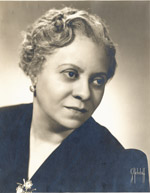 If there is ever to be a major Florence Price revival, Maestro Mei-Ann Chen will surely be one of its driving forces. The Sinfonietta performed her work The Oak in their 2012 MLK Tribute concert, and Mei-Ann also led the Chicago Symphony Orchestra in Price’s Mississippi River Suite last year as well as conducting her Symphony No. 1 in last year’s Sinfonietta season opener. It’s only natural for Mei-Ann and the Sinfonietta to be her champions, as Florence Price was the first African-American woman acknowledged as a symphonic composer.
If there is ever to be a major Florence Price revival, Maestro Mei-Ann Chen will surely be one of its driving forces. The Sinfonietta performed her work The Oak in their 2012 MLK Tribute concert, and Mei-Ann also led the Chicago Symphony Orchestra in Price’s Mississippi River Suite last year as well as conducting her Symphony No. 1 in last year’s Sinfonietta season opener. It’s only natural for Mei-Ann and the Sinfonietta to be her champions, as Florence Price was the first African-American woman acknowledged as a symphonic composer.
Price was born and began her music career in Arkansas after studying at the New England Conservatory of Music. However, worsening racial tension in Arkansas convinced Price to move to Chicago in 1927, where she studied at the American Conservatory of Music and Chicago Musical College and established herself as a teacher, pianist, and organist. In 1932, she composed Symphony No. 1, and it received its debut by the Chicago Symphony Orchestra in 1933, the first time a black woman had her work presented on such a stage. Dances in the Canebrakes, originally written for solo piano, debuted in 1953, and you can hear quite a bit of southern folk songs and spirituals in its three movements.
The Arkansas Encyclopedia of History and Culture has a fairly thorough chapter on Price. There are no available videos of Canebrakes, but the 4th movement of her 3rd Symphony, as heard in this video, uses some of the same sources and has a similar feel.
Benjamin Britten
Young Persons Guide to the Orchestra - Variations and Fugue on a Theme by Purcell
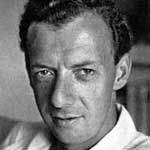 The Young Person's Guide to the Orchestra, written in 1946, was originally commissioned for an educational documentary film called Instruments of the Orchestra, featuring the London Symphony Orchestra conducted by Malcolm Sargent. The work is one of the best-known pieces by the British composer, and is often associated with two other works in the context of children's music education: Saint-Saëns' The Carnival of the Animals and Prokofiev's Peter and the Wolf.
The Young Person's Guide to the Orchestra, written in 1946, was originally commissioned for an educational documentary film called Instruments of the Orchestra, featuring the London Symphony Orchestra conducted by Malcolm Sargent. The work is one of the best-known pieces by the British composer, and is often associated with two other works in the context of children's music education: Saint-Saëns' The Carnival of the Animals and Prokofiev's Peter and the Wolf.
If all of this sounds familiar, it is likely because of the landmark television series created by American composer and conductor Leonard Bernstein in 1960. Bernstein created the show for the purpose of exposing young viewers to classical music and various kinds of orchestral instruments as well. Britten’s work, of course, was an inspiration. In the introduction, the theme is initially played by the entire orchestra, then by each major family of instruments of the orchestra: first the woodwinds, then the brass, then the strings, and finally by the percussion. After the whole orchestra has been effectively taken to pieces in this way, it is reassembled using an original fugue which starts with the piccolo, followed by all the woodwinds, strings, brass and percussion in turn. Once everyone has entered, the brass are re-introduced with a strike on the gong.
The playful nature of the work is the perfect transition to the introduction of Mucca Pazza.
The Britten 100 website celebrated the composer's 100th birthday in 2013. In the video, Michael Tilson Thomas conducts Part 1 of the piece.
Mark Messing
Holiday on Ice (Orchestrated by Joe Clark)
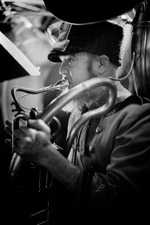 Mark Messing is a composer, musical agitator and the music director of Mucca Pazza. He has led the band from coast to coast through concert halls, public parks, neighborhood pubs and a dozen canoes on the Chicago River. He also scores independent films and has been the musical director for literally hundreds of theater performances, including those of occasional Sinfonietta collaborators Redmoon Theater. His new company, Opera-Matic, performs Lullaby Parades on bicycle powered floats in Chicago neighborhoods at twilight.
Mark Messing is a composer, musical agitator and the music director of Mucca Pazza. He has led the band from coast to coast through concert halls, public parks, neighborhood pubs and a dozen canoes on the Chicago River. He also scores independent films and has been the musical director for literally hundreds of theater performances, including those of occasional Sinfonietta collaborators Redmoon Theater. His new company, Opera-Matic, performs Lullaby Parades on bicycle powered floats in Chicago neighborhoods at twilight.
Joe Clark is an orchestrator who previously worked with the Chicago Sinfonietta on Mei-Ann Chen’s subscription concert debut as Music Director, putting together the marching band plus orchestra version of the Frank Sinatra classic “My Kind of Town, Chicago Is” as Mei-Ann’s greeting to her new home city.
As mentioned, Mucca Pazza doesn’t necessarily march. Sometimes, in fact, they play “Sitting in Chairs.” Messing conducts them here at a WBEZ performance broadcast live on Tony Sarabia’s Morning Shift program in April 2013.
Gustav Mahler
Excerpt from Symphony No. 1 in D major, Mvt III
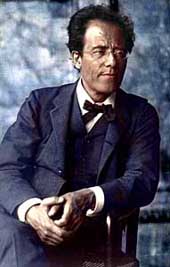 The concert returns to purely classical territory with this excerpt from one of the German composer’s massive symphonies. It picks up on the Germanic spirit that characterizes so much band music, including marching bands and wind ensembles. And though it would be fair to say that Mahler is generally regarded as a serious sort, the weaving of the children’s nursery rhyme Frère Jacques into a funeral march in this movement certainly counts as a musical wink, if not an outright joke. It is a spirit that Mucca Pazza knows well.
The concert returns to purely classical territory with this excerpt from one of the German composer’s massive symphonies. It picks up on the Germanic spirit that characterizes so much band music, including marching bands and wind ensembles. And though it would be fair to say that Mahler is generally regarded as a serious sort, the weaving of the children’s nursery rhyme Frère Jacques into a funeral march in this movement certainly counts as a musical wink, if not an outright joke. It is a spirit that Mucca Pazza knows well.
Writing ten symphonies and inspiring composers as diverse as Shostakovich and Schoenberg, Gustav Mahler is regarded as one of the most influential composers of his generation, his work pushing the boundaries of symphonic form. His Symphony No.8 required so many musicians and singers it has been nick-named the “Symphony of a Thousand.”
Gramophone Magazine has one of the best introductions to Mahler and his works. This video features the entire third movement of the symphony.
Dave Smith
Rabbits and Trees (Orchestrated by Joe Clark)
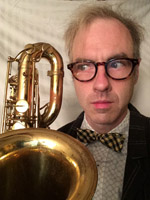
Dave Smith is a woodwind player and one of the principle composers for Mucca Pazza. Rabbits and Trees appears on their most recent album Safety Fifth. As is often the case with Mucca, dozens of influences whiz in and out. It starts off as a straight-up half-time show march, then quickly morphs into a drunken waltz at a Balkan wedding and features a brief klezmer interlude punctuated by tuba and trombone. It reminds me, in its rhythmic and tonal shifts, a bit of that notable avant-gardist Frank Zappa circa Hot Rats, whimsical but with a similar seriousness of execution.
Even with all of this, Rabbits and Trees is somewhat (relatively speaking) sedate, reflecting the more nuanced approach the band takes when they are "Sitting in Chairs."
This video features the complete Rabbits and Trees as it appears on Safety Fifth.
Pyotr Ilyich Tchaikovsky, orchestration by Joe Clark
1812 Overture, op. 49
 It might be the most recognizable bit of classical music in all time, with the opening notes of Beethoven’s Fifth Symphony a close second. The overture was written in 1880 by Russian composer Tchaikovsky to commemorate Russia's defense of its motherland against Napoleon's invading Grande Armée in 1812. It has also become a common accompaniment to fireworks displays, including those in the United States during Fourth of July celebrations, so much so that many Americans assume it’s about them. It is, to say the least, loud. We may not have fireworks or cannons, but, with the help of Mucca Pazza, we will have lots of drummers to bring the noise and at the same time, poke a little fun at the piece’s overtly martial bombast.
It might be the most recognizable bit of classical music in all time, with the opening notes of Beethoven’s Fifth Symphony a close second. The overture was written in 1880 by Russian composer Tchaikovsky to commemorate Russia's defense of its motherland against Napoleon's invading Grande Armée in 1812. It has also become a common accompaniment to fireworks displays, including those in the United States during Fourth of July celebrations, so much so that many Americans assume it’s about them. It is, to say the least, loud. We may not have fireworks or cannons, but, with the help of Mucca Pazza, we will have lots of drummers to bring the noise and at the same time, poke a little fun at the piece’s overtly martial bombast.
About.com has a dryly amusing article about how the 1812 Overture became so popular in the U.S. And if you really need to hear cannon fire, you can do so in this video clip of the overture’s conclusion.
Research and copywriting by Don Macica.
Don is a marketing consultant to the performing arts community and a contributing writer to several online publications including Chicagomusic.org and Arteyvidachicago.com. When not traveling, he lives a stone's throw from Lake Michigan in Chicago’s Rogers Park neighborhood. He is the author of Border Radio, a blog about music, migration and cultural exchange.
